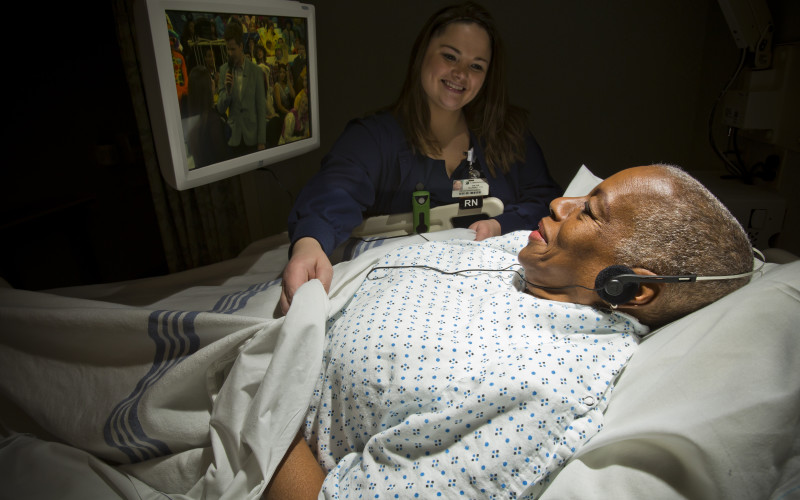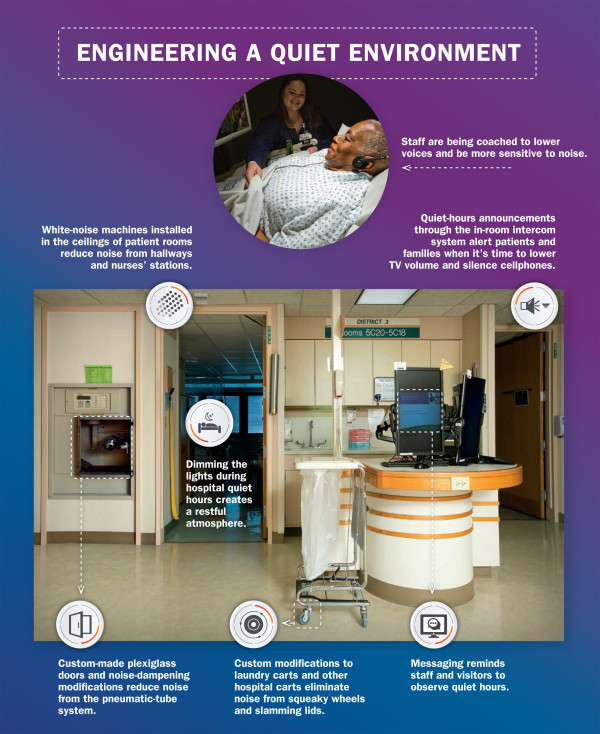Quiet at Night initiative helps patients get better sleep at night

It’s 9 p.m. and the lights are dimmed on 5C at Christiana Hospital. A soothing voice announces that quiet time has begun, a nine-hour period when conversation is hushed, cellphones and pagers are placed on vibrate and patients who want to watch TV put on earphones.
Quiet at Night is a multidisciplinary campaign at Christiana Care to reduce noise and improve the patient experience. The second six-month Quiet at Night Challenge, launched Jan. 1, builds on last year’s challenge in which overall HCAHPS scores improved three percentage points, and nine of 24 units exceeded five-point improvements. On 5C, scores improved 23 percent.

As they began to tackle the complex problem of hospital noise, the Patient Environment Committee took an unusual step: They moved meetings to nightime, so that they could directly engage the staff who were working during hospital quiet hours.“These successes are due to the efforts of the entire staff working together for the good of patients,” said Shawn R. Smith, MBA, vice president, Patient Experience, and co-chair, Patient Environment Committee. “Quiet at Night is truly a healing time, a time to rest your mind, rest your body.”
“We would do rounds at 9 p.m. before our 10 o’clock meeting,” said Robert Mulrooney, vice president, Facilities and Services, and co-chair of the committee. “That enabled us to talk to them staff and ask for suggestions.”
Pharmacy carts were an immediate concern.
“The carts would shake, rattle and roll, so to speak,” said Joe Foss, Facilities engineering manager. “We also addressed noise issues with the tube system and the lids on linen carts.”
Replacing metal carts with plastic models would have been expensive — $300 for plastic, compared to $82 for a standard cart. “We found that we could adjust the existing carts for $25-$40, a significant savings,” Foss said.
Facilities also fabricated doors to go over the tube stations and added padding so noise wouldn’t travel from tube stations to the rooms. They modified linen carts with pistons that prevent the lid from slamming, and with new wheels that are substantially quieter than the stock wheels. Many of the solutions didn’t require any expense, such as closing the doors to rooms of patients who are not considered a fall risk.
At the Center for Advanced Joint Replacement at Wilmington Hospital, concerns about noise were part of the design.
“We use a lot of ice, and the motor on the ice machine in the hallway of the old unit was noisy,” said Terry Foraker, MSN, RN, nurse manager. “When we knew that we were moving, we put the ice machine behind doors.”
Closing doors to patient rooms and adjusting noisy doors and handles helped, too. As a result the unit earned the highest overall quiet score, 69 percent.
“We were among the noisiest because we wake people up the first night to check their vital signs,” she said. “The night shift really bought into this, holding one another accountable, and it has made all the difference.”
Samantha Davis, MSN, RN-BC, assistant nurse manager on 2C, participated in the night meetings of the Patient Environment Committee. She said engaging the staff nurtured enthusiasm for the initiative.
“We talked about what Quiet at Night means to patients and their health,” she said. “It’s not just being quiet. It’s helping your mom or your sister to get a good night’s sleep.”
A scripted message for care providers helps them to explain the initiative without being abrasive. Davis also was conscious of being a role model for others.
“I would intentionally talk very low, so people who respond also would speak softly,” she said.
On 5C, the soothing voice announcing quiet time belongs to Anita Brown, a unit clerk who recorded the message on an iPhone. Each evening, the message is played through the intercom at the nurses’ station.
Additionally, every patient on the floor receives a quiet pack that includes headphones and a note asking patients to be respectful of their roommates’ need for rest. Signs are posted on doors as a reminder. Lights are dimmed at 8:30 p.m.
“We have a very involved team,” said John McMillen, MBA, MS, BSN, RN, nurse manager, 5C. “Everyone is mindful of their conversations in the hallway and the volume of their voices.”